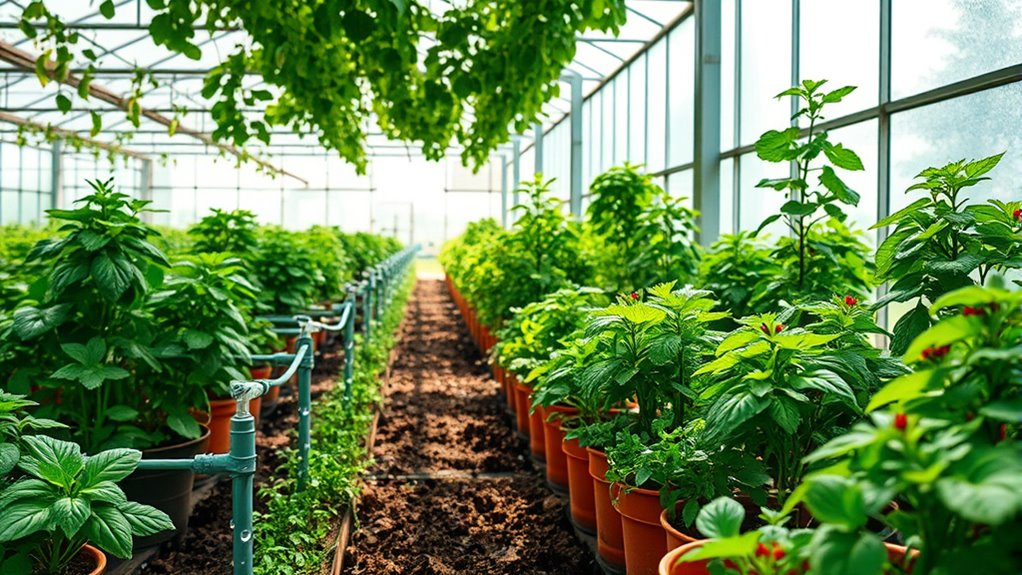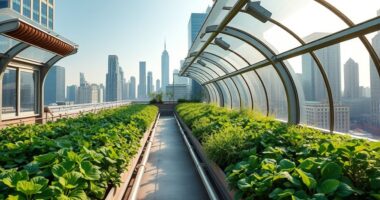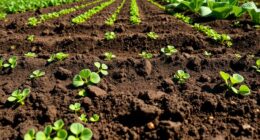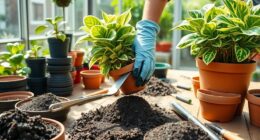To conserve water in your greenhouse, you can implement drip irrigation systems for direct water delivery, which minimizes evaporation. Rainwater harvesting is another great method, capturing rain for irrigation. Consider grey water recycling to repurpose water from sinks and showers. Combine these techniques with innovative technologies like climate control systems and soil moisture sensors to optimize efficiency. These strategies can reduce your water usage significantly. There's much more to explore, so keep on discovering additional techniques!
Key Takeaways
- Implement drip irrigation systems to deliver water directly to plant roots, reducing evaporation and runoff while enhancing crop yield.
- Utilize rainwater harvesting techniques by collecting rainwater from greenhouse roofs, providing a cost-effective and sustainable irrigation source.
- Recycle grey water from sinks and showers for irrigation, reducing wastewater and conserving fresh water resources.
- Incorporate soil moisture sensors to monitor water levels and optimize irrigation schedules, ensuring precise watering and minimizing waste.
- Develop a comprehensive water management plan tailored to specific crops, focusing on peak usage times and sustainable practices to reduce costs.
Drip Irrigation Systems
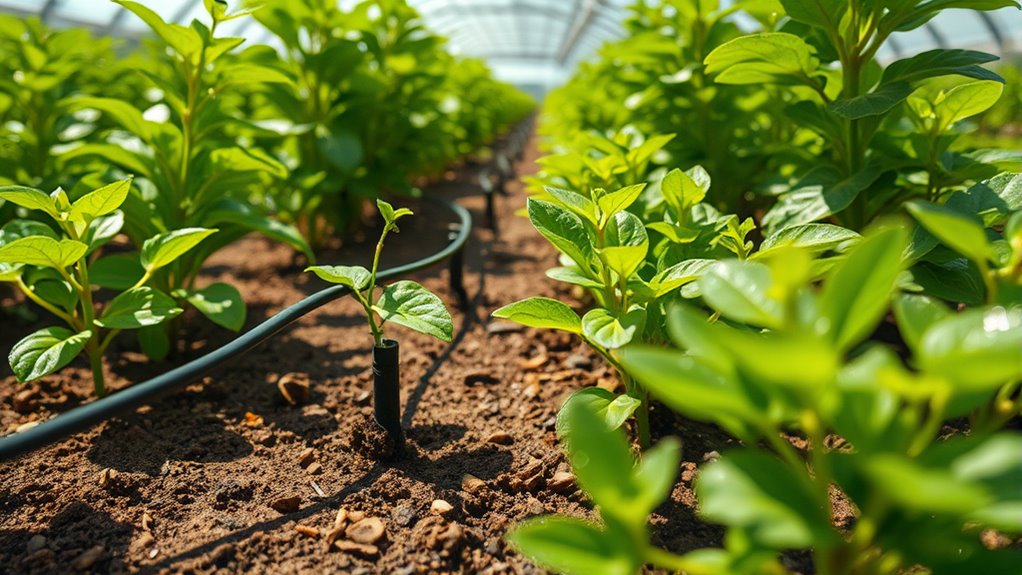
Drip irrigation systems are a game-changer for greenhouse water conservation, offering efficient water delivery directly to plant roots. You'll notice significant water savings, as these systems use less water than traditional methods, reducing evaporation and runoff. With precise watering, you can boost crop yield by up to 90% while minimizing disease risk by keeping water off leaves. The scalability of drip systems means they fit any greenhouse size, making them versatile. Essential components like timers, pressure regulators, and filters ensure optimal performance. Plus, you'll enjoy energy savings from reduced water pumping costs. By implementing drip irrigation, you not only enhance plant growth but also contribute to a more sustainable greenhouse environment, as it promotes proper air and moisture ratio. It's a smart choice for any grower!
Rainwater Harvesting

Rainwater harvesting is an innovative approach that significantly enhances water conservation in greenhouses. By collecting rainwater from your greenhouse roof using gutters and downspouts, you create a low-cost irrigation source that reduces expenses.
This water is often purer than tap water, promoting healthier plant growth free from chemicals. Implementing a rainwater system also supports sustainable practices, decreasing your reliance on municipal supplies and helping combat drought conditions. Rainwater collection offers affordable solutions for personal, commercial, and agricultural water supplies.
You'll need to maintain your gutters and storage tanks to ensure water quality, and using metal roofs can optimize collection.
With proper filtration systems in place, you can deliver nutrient-rich rainwater directly to your plants, making your greenhouse operations more efficient and eco-friendly.
Grey Water Recycling
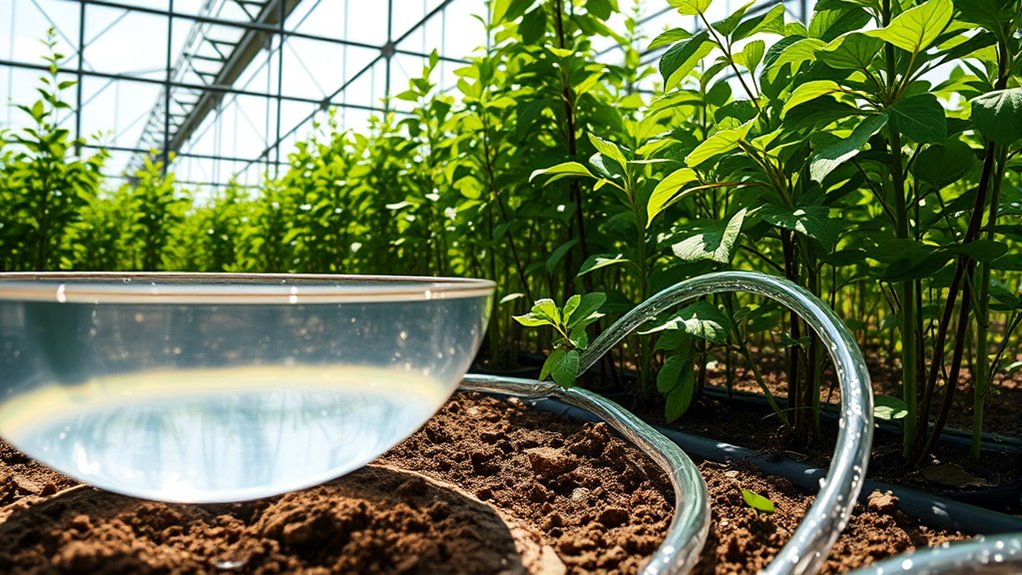
Grey water recycling is an effective strategy for conserving water in greenhouses, allowing you to utilize water from sinks, showers, and laundry without the need for complex treatment.
This water can be collected from various household sources, excluding toilets, and helps reduce the amount entering sewers. You can treat grey water using woodchip biofilters and constructed wetlands, making it safe for irrigating non-edible plants like ornamental varieties and fruit trees. Regular maintenance is crucial to ensure your system functions well, and monitoring water quality is essential. While grey water can aid in maintaining soil moisture, be mindful of potential contaminants that could affect plant health. Additionally, gravity-based systems must be designed to prevent standing water to avoid freezing issues in cold climates.
Efficient Irrigation Techniques

Utilizing water wisely is vital for greenhouse sustainability, and efficient irrigation techniques play a key role in this effort. You can implement drip irrigation to deliver water directly to plant roots, minimizing evaporation and runoff. Micro-sprinkler systems provide uniform coverage and can enhance air circulation for various crops. Consider subsurface drip irrigation systems that reduce water and fertilizer usage by up to 50% through capillary action. Portable camping toilets can also help manage water use effectively by providing a clean waste disposal solution. Optimize your watering times by irrigating in the morning when plants are most active. Regularly inspect for leaks to prevent waste and use soil moisture sensors for precise watering. Grouping plants with similar water needs and ensuring proper greenhouse insulation can further conserve water, making your greenhouse more efficient and sustainable.
Innovative Technologies
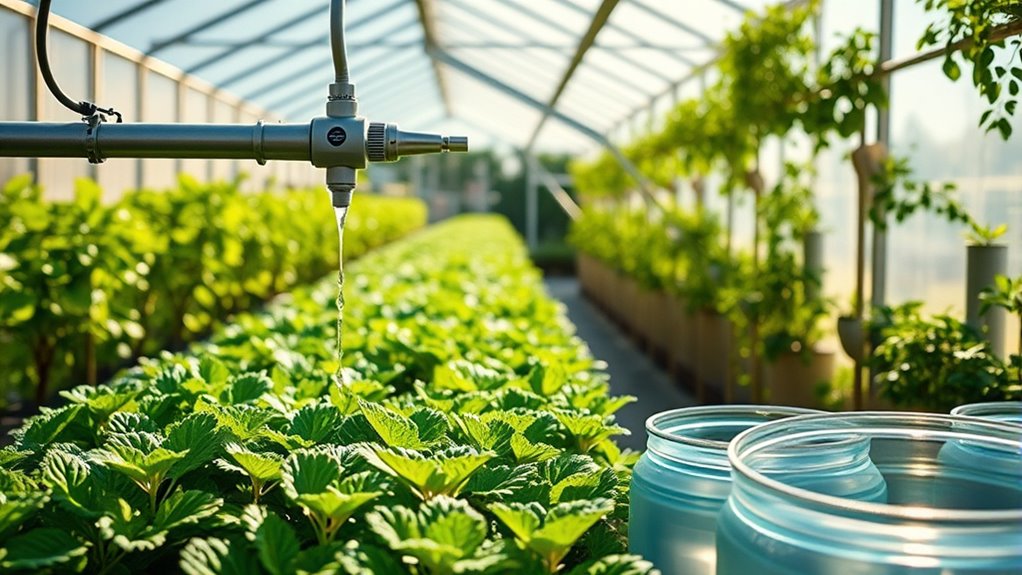
As greenhouse managers seek sustainable solutions, innovative technologies are revolutionizing water conservation practices.
Smart climate control systems adjust temperature and humidity in real-time, reducing water evaporation and optimizing usage. Greenhouses create ideal microclimates that help minimize water loss due to evaporation.
Hydroponics and aeroponics eliminate soil, using nutrient-rich water and misting techniques to minimize waste while promoting plant growth.
Water recycling systems allow you to treat and reuse irrigation water, significantly lowering your water footprint.
Advanced materials like superabsorbent polymers help retain moisture in the soil, while atmospheric water harvesting technologies extract moisture from the air to supplement irrigation.
Additionally, seawater desalination presents a promising option for coastal greenhouses, turning saltwater into a resource for irrigation.
Greenhouse Design Considerations

When designing a greenhouse, it's essential to consider factors that optimize water conservation and overall efficiency.
Start with proper insulation and materials like glass or polycarbonate to reduce heat loss and evaporation. Incorporate shading mechanisms to limit water needs by allowing only necessary light.
Effective ventilation systems can help manage temperature and humidity, further minimizing evapotranspiration. Optimize space by planting crops closer together, shortening their growing cycle and reducing water use. Additionally, ensure that soil water content is maintained at 70%-80% for optimal growth and water efficiency.
Implementing drip irrigation systems delivers water directly to the roots, maximizing efficiency.
Finally, consider integrating rainwater harvesting and storage solutions to supplement your water supply.
Plant Selection and Management
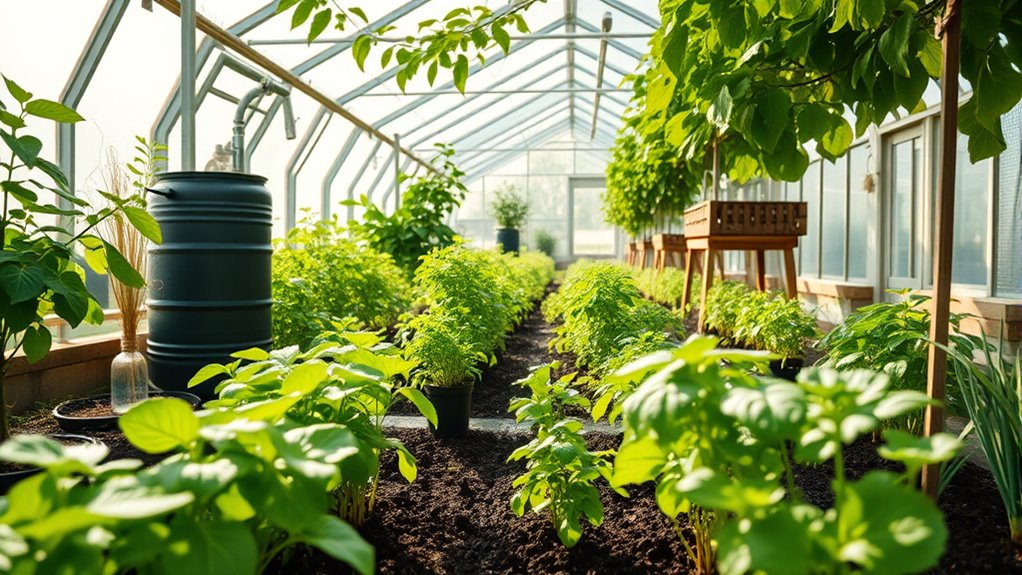
Selecting the right plants for your greenhouse is crucial for maximizing water conservation and promoting healthy growth. Start by choosing crops with shorter growth cycles, like kale, melons, and cucumbers, which thrive in water-efficient conditions. Consider climate adaptation; select plants that suit your local environment to cut down on heating and cooling needs. Incorporating drought-tolerant varieties helps reduce water consumption during dry spells. For optimal management, space your plants closely to minimize soil exposure and employ taller plants for shading smaller ones, reducing evapotranspiration. Water evaporation is minimized in a greenhouse environment, further enhancing water conservation efforts. Rotate your crops regularly to maintain soil health and prevent water-borne diseases. These strategies not only conserve water but also enhance the overall productivity of your greenhouse.
Monitoring and Management
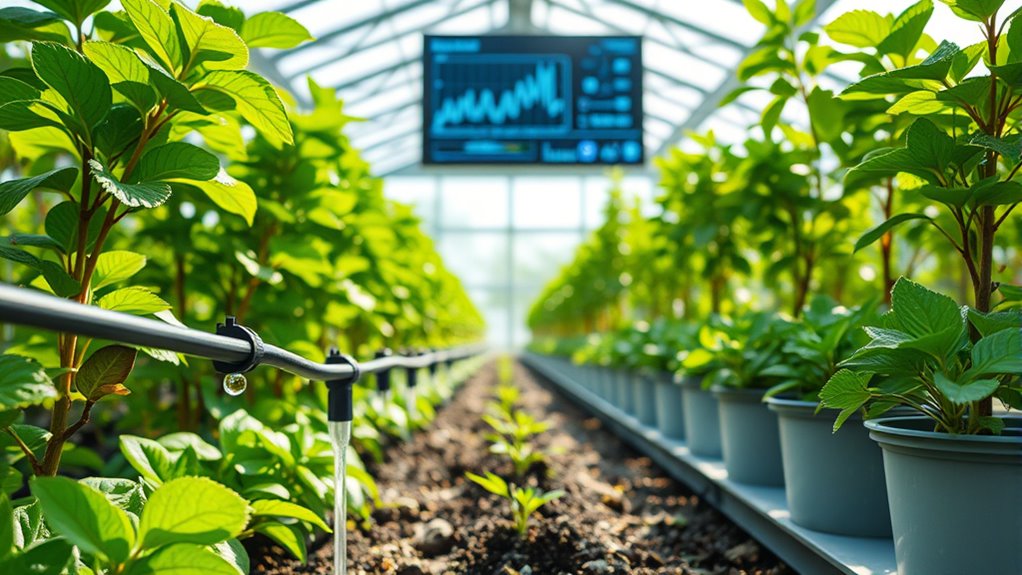
Effective monitoring and management are essential for optimizing water use in your greenhouse. By utilizing sensor technology, you can track temperature, humidity, and soil moisture, ensuring precise irrigation. Additionally, the Kapiʻolani Community College greenhouse preserves native plants to combat climate change, highlighting the importance of sustainable practices in water management. Implementing solar energy solutions can further enhance the efficiency of your greenhouse operations by powering irrigation systems sustainably.
Implement data analytics to identify trends and inefficiencies in your water usage, allowing for informed management strategies. IoT devices provide real-time data to enhance decision-making, while automated alerts help you address any irregularities promptly. Incorporating drip irrigation and rainwater harvesting can significantly boost efficiency, while soil moisture sensors enable targeted watering. Regular monitoring detects leaks, minimizing water loss. Finally, tools like cloud-based platforms facilitate remote access to your water management data, ensuring you can make swift, informed decisions for your greenhouse's needs.
Water Management Plans

Establishing a comprehensive water management plan is vital for maximizing efficiency and sustainability in your greenhouse. Start by identifying water sources, like rainwater harvesting, groundwater, or municipal supplies, ensuring each option is accessible and reliable.
Implement drip irrigation systems to deliver water directly to plant roots, minimizing waste. Use soil moisture sensors to monitor conditions and adjust watering schedules accordingly.
Consider recycling water through closed hydroponic systems, analyzing drain water to maintain nutrient balance. Regularly test water quality to safeguard plant health.
Additionally, plan for peak usage times and ensure your infrastructure can handle these demands. By tailoring your water management plan to your specific crops and greenhouse size, you'll optimize water use and promote conservation. Effective water use lowers greenhouse operating expenses and supports overall sustainability efforts.
Frequently Asked Questions
How Can I Calculate My Greenhouse's Water Needs?
To calculate your greenhouse's water needs, start by measuring the growing area in square feet.
Then, estimate peak use rates, which typically range from 0.3 to 0.4 gallons per square foot daily.
Factor in evapotranspiration rates based on your climate and crop type.
Monitor irrigation frequency, taking soil moisture levels into account.
Adjust these calculations seasonally, particularly during hotter months, to ensure your plants receive the right amount of water without waste.
What Are the Legal Regulations for Rainwater Harvesting?
Navigating the maze of rainwater harvesting regulations can feel like dancing through a legal labyrinth.
You'll find that federal laws don't govern this; it's up to your state. Some states require permits, while others offer tax incentives.
Restrictions might limit your use of harvested rainwater to non-potable purposes, and local ordinances can add more rules.
Always check specific laws in your area to ensure compliance and make the most of your system.
Can I Use Kitchen Wastewater for Irrigation?
You can use kitchen wastewater for irrigation, but you need to be cautious.
First, treat the wastewater to eliminate harmful substances like soap and detergents that could harm your plants. While it can provide beneficial nutrients, it might also cause nutrient imbalances.
Make sure to check local regulations, as there could be restrictions on using such water for irrigation.
Proper treatment and awareness of regulations will help you use it safely and effectively.
What Is the Cost of Implementing Water Conservation Strategies?
Implementing water conservation strategies can vary in cost.
For instance, drip irrigation systems might require an initial investment but save you money over time by reducing waste.
Rainwater harvesting involves higher upfront costs for storage tanks, while subirrigation systems offer a cost-effective alternative.
Additionally, investing in irrigation controllers can automate your watering and lower labor costs.
Don't forget to account for potential maintenance expenses to ensure your systems run efficiently and effectively.
How Do I Choose Drought-Tolerant Crops for My Greenhouse?
When it comes to choosing drought-tolerant crops for your greenhouse, think of them as nature's water-savers.
Start by selecting varieties like chili peppers and okra, which thrive on minimal water.
Consider your local climate to ensure they adapt well.
Focus on market demand to maximize your investment.
Conclusion
By embracing these water conservation techniques, you're not just nurturing your plants; you're cultivating a sustainable future. From drip irrigation to innovative technologies, every drop counts and can make a world of difference in your greenhouse. Remember, smart design and careful plant management can turn your greenhouse into a thriving oasis. So, let's turn the tide on water waste and grow greener together—because when it comes to conservation, every little effort adds up to a big impact.
